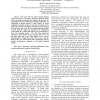Free Online Productivity Tools
i2Speak
i2Symbol
i2OCR
iTex2Img
iWeb2Print
iWeb2Shot
i2Type
iPdf2Split
iPdf2Merge
i2Bopomofo
i2Arabic
i2Style
i2Image
i2PDF
iLatex2Rtf
Sci2ools
ICRA
2005
IEEE
2005
IEEE
Performance of Surgical Robots with Automatically Generated Spatial Virtual Fixtures
– Our recent work on robotic surgical assistant systems has led us to develop a method to generate spatial motion constraints associated with complex 3D geometry for controlling a robot in a complicated working configuration. An application of specific interest is sinus surgery, in which complicated anatomic structure constrains the motion of the endoscope and other instruments, which are inserted through the nose into a sinus cavity. We have implemented this method in both hands-on cooperative operation and teleoperation control mode. We evaluate and compare user performance in these two operation modes. We show that cooperative operation is more intuitive for the user and easier to use. On the other hand, due to the robot stiffness of our current implementation, teleoperation mode shows more accurate. Both of these two robot-assisted modes significantly improve human’s performance compared to the totally freehand motion.
Cooperative Operation | ICRA 2005 | Robotics | Spatial Motion Constraints | Teleoperation Control Mode |
| Added | 25 Jun 2010 |
| Updated | 25 Jun 2010 |
| Type | Conference |
| Year | 2005 |
| Where | ICRA |
| Authors | Ming Li, Russell H. Taylor |
Comments (0)

